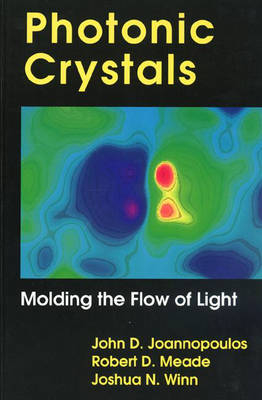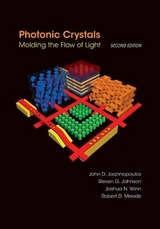
Photonic Crystals
Molding the Flow of Light
Seiten
1995
Princeton University Press (Verlag)
978-0-691-03744-8 (ISBN)
Princeton University Press (Verlag)
978-0-691-03744-8 (ISBN)
- Titel erscheint in neuer Auflage
- Artikel merken
Zu diesem Artikel existiert eine Nachauflage
Addresses the discovery of photonic band-gap materials and their use in controlling the propagation of light. This book shows that many of the properties of an electron in a semiconductor crystal can apply to a particle of light in a photonic crystal. It offers a treatment of the traditional multilayer film.
"Photonic Crystals" is the first book to address one of the newest and most exciting developments in physics - the discovery of photonic band-gap materials and their use in controlling the propagation of light. Recent discoveries show that many of the properties of an electron in a semiconductor crystal can apply to a particle of light in a photonic crystal. This has vast implications for physicists, materials scientists, and electrical engineers and suggests such possible developments as an entirely optical computer. Combining cutting-edge research with the basic theoretical concepts behind photonic crystals, the authors present to undergraduates and researchers a concise, readable, and comprehensive text on these novel materials and their applications. The first chapters develop the theoretical tools of photonic crystals in a broad, intuitive fashion, starting from nothing more than Maxwell's equations and Fourier analysis, and include analogies to traditional solid-state physics and quantum theory. There follows an investigation of the unique phenomena that take place within photonic crystals, at defect sites, and at surfaces and interfaces.
The authors offer a new treatment of the traditional multilayer film (a one-dimensional photonic crystal), which allows for the extension to higher dimensions and more complex geometries. After exploring the capabilities of photonic crystals to guide and localize light, the authors demonstrate how these notions can be put to work.
"Photonic Crystals" is the first book to address one of the newest and most exciting developments in physics - the discovery of photonic band-gap materials and their use in controlling the propagation of light. Recent discoveries show that many of the properties of an electron in a semiconductor crystal can apply to a particle of light in a photonic crystal. This has vast implications for physicists, materials scientists, and electrical engineers and suggests such possible developments as an entirely optical computer. Combining cutting-edge research with the basic theoretical concepts behind photonic crystals, the authors present to undergraduates and researchers a concise, readable, and comprehensive text on these novel materials and their applications. The first chapters develop the theoretical tools of photonic crystals in a broad, intuitive fashion, starting from nothing more than Maxwell's equations and Fourier analysis, and include analogies to traditional solid-state physics and quantum theory. There follows an investigation of the unique phenomena that take place within photonic crystals, at defect sites, and at surfaces and interfaces.
The authors offer a new treatment of the traditional multilayer film (a one-dimensional photonic crystal), which allows for the extension to higher dimensions and more complex geometries. After exploring the capabilities of photonic crystals to guide and localize light, the authors demonstrate how these notions can be put to work.
John D. Joannopoulos is Professor of Physics at the Massachusetts Institute of Technology. Robert D. Meade is a Research Scientist and Joshua N. Winn is a graduate student, both at MIT.
| Acknowledgments | ||||||||||||||||||||||||
| Ch. 2 | Electromagnetism in Mixed Dielectric Media | |||||||||||||||||||||||
| Ch. 3 | Symmetries and Solid-State Electromagnetism | |||||||||||||||||||||||
| Ch. 4 | The Traditional Multilayer Film: A One-Dimensional Photonic Crystal | |||||||||||||||||||||||
| Ch. 5 | Two-Dimensional Photonic Crystals | |||||||||||||||||||||||
| Ch. 6 | Three-Dimensional Photonic Crystals | |||||||||||||||||||||||
| Ch. 7 | Designing Photonic Crystals for Applications | |||||||||||||||||||||||
| Appendix A. Comparisons with Quantum Mechanics | ||||||||||||||||||||||||
| Appendix B. The Reciprocal Lattice and the Brillouin Zone | ||||||||||||||||||||||||
| Appendix C. Atlas of Band Gaps for Two-Dimensional Photonic Crystals | ||||||||||||||||||||||||
| Appendix D. Computing Photonic Band Structures | ||||||||||||||||||||||||
| References | ||||||||||||||||||||||||
Index
Mehr entdecken
aus dem Bereich Grundlagen - Verfahren - Anwendungen - Beispiele
Buch | Hardcover (2022)
Hanser, Carl (Verlag)
49,99 €
Grundlagen und Anwendungen
Buch | Hardcover (2023)
Hanser, Carl (Verlag)
59,99 €
| ||||||||||||||||||||||||



